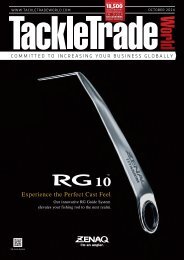You also want an ePaper? Increase the reach of your titles
YUMPU automatically turns print PDFs into web optimized ePapers that Google loves.
SPOTLIGHT ON...<br />
reels<br />
SPOTLIGHT ON<br />
REELS<br />
With a couple of exceptions, fishing reels are essential tools in angling, designed<br />
to assist in the retrieval and deployment of your line. There are various types, each<br />
serving specific purposes, catering to different fishing styles and at different price<br />
points. Here‘s your guide…<br />
Almost every method or style of<br />
fishing requires a reel – aside<br />
from pole fishing and Tenkara<br />
– and most reels are specific to the style<br />
or discipline they are designed to service,<br />
although there some variations on a<br />
theme.<br />
From ultra-lightweight fly reels to fixed<br />
spool ‘spinning’ reels in a bewildering<br />
array of sizes through to giant multipliers<br />
capable of holding thousands of yards of<br />
line to handle huge jigs and lures used<br />
in offshore fishing. There are even some<br />
which wind the line in automatically.<br />
FiXeD spool reels<br />
Arguably the most popular type as<br />
they are easy to use, often cheap to<br />
buy, require little maintenance and are<br />
favoured for a wide variety of fishing<br />
disciplines, from float fishing on rivers,<br />
lakes or at sea, to hauling in big carp<br />
and catfish, to casting lures for bass and<br />
predators across the globe.<br />
A fixed spool reel is based around a<br />
non-rotating spool that is, as the name<br />
implies, fixed in place. A bail arm rotates<br />
around this spool and winds line around<br />
it when reeling in.<br />
Generally speaking, the more ball<br />
bearings a reel has, the better it will<br />
perform. Entry-level fixed spool reels<br />
are likely to have a single ball bearing,<br />
whereas high-end reels will have many<br />
more.<br />
Fixed spool reels offer either front<br />
drag or rear drag options but with either<br />
system the aim is to allow line to slowly<br />
peel off the reel before the force of a<br />
fighting fish snaps it.<br />
As technology improves, reels are<br />
getting lighter and stronger while<br />
offering improved line lay for smoother<br />
casting among other advancements.<br />
One key development to fixed spool<br />
reels occurred back in 1985 when<br />
Shimano introduced its revolutionary<br />
Baitrunner reels.<br />
These free-spool reels (as every other<br />
manufacturer had to call them thanks<br />
to Shimano wisely trademarking the<br />
Baitrunner name) were targeted at the<br />
growing carp market across Europe<br />
and essentially meant that line could<br />
be pulled off the reel with the bail arm<br />
closed, allowing a fish to run with the<br />
bait it had picked up.<br />
24 www.tackletradeworld.com


















